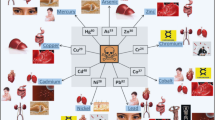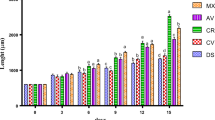Abstract
Se is required for the growth and metabolism of many species of microalgae. However, high concentrations of Se show toxicity to microalgal cells. In the study, the biomass, growth rate, total Se content, organic Se content, SOD, CAT, and LPO of Chlorella pyrenoidosa in an environment containing Se were determined to explore the effects of selenite on the growth of C. pyrenoidosa in different growth phases (exponential phase, late exponential phase, and early stationary phase). Bioaccumulation and conversion of selenium in C. pyrenoidosa and toxic effect of selenium were further explored. A low dosage of selenite could promote the growth of C. pyrenoidosa, but the higher Se concentration strongly inhibited growth and led to the low biomass. Algae cells in exponential phase could be exposed to high doses of selenium (≤ 5 mg L−1), which was higher than that for the cells in late exponential phase (≤ 2 mg L−1) and the cells in early stationary phase (≤ 2 mg L−1). The optimal growth conditions for enriching selenium in C. pyrenoidosa in exponential phase were determined as 2 mg L−1 selenite and 5-day cultivation. The highest transformation mass was 78 ± 0.5% and corresponding intracellular accumulation of organic Se was 72 ± 0.1 μg g−1 dry weight. The lower Se concentration induced the activities of oxidases, which was conducive to the growth of microalgal cells. The higher concentration of Se significantly induced the activities of oxidases, indicating that Se accumulation had a significant toxic effect on C. pyrenoidosa. In this way, a great quantity of Se-enriched biomass can be produced for nutritional purposes.





Similar content being viewed by others
References
Affenzeller MJ, Darehshouri A, Andosch A, Lütz C, Lütz-Meindl U (2009) Salt stress-induced cell death in the unicellular green alga Micrasterias denticulata. J Exp Bot 60:939–954
Araie H, Shiraiwa Y (2016) Selenium in algae. In: Borowitzka MA, Beardall J, Raven JA (eds) The physiology of microalgae. Springer, Dordrecht, pp 281–288
Babaei A, Ranglová K, Malapascua JR, Masojíde J (2017) The synergistic effect of Selenium (selenite, –SeO32−) dose and irradiance intensity in Chlorella cultures. ABM Express 7 (56)
Banerjee C, Gupta P, Mishra S, Sen G, Shukla P, Bandopadhyay R (2012) Study of polyacrylamide grafted starch based algal flocculation towards applications in algal biomass harvesting. Int J Biol Macromol 51:456–461
Bradford MM (1976) A rapid and sensitive method for the quantitation of microgram quantities of protein utilizing the principle of protein-dye binding. Anal Biochem 72:248–254
Combs GF (2001) Selenium in global food systems. Br J Nutr 85:517–547
De Alcantara S, Lopes CC, Wagener K (1998) Controlled introduction of selenium into Chlorella cells. Indian J Exp Biol 36:1286–1288
Ekelund NGA, Danilov RA (2001) The influence of selenium on photosynthesis and “light-enhanced dark respiration” (LEDR) in the flagellate Euglena gracilis after exposure to ultraviolet radiation. Aquat Sci 63:457–465
Fernández-Martínez A, Charlet L (2009) Selenium environmental cycling and bioavailability: a structural chemist point of view. Rev Env Sci Biotechnol 8:81–110
Fournier E, Adam-Guillermin C, Potin-Gautier M, Pannier F (2010) Selenate bioaccumulation and toxicity in Chlamydomonas reinhardtii: influence of ambient sulphate ion concentration. Aquat Toxicol 97:51–57
Geoffroy L, Gilbin R, Simon O, Floriani M, Adam C, Pradines C, Cournac L, Garnier-Laplace J (2007) Effect of selenate on growth and photosynthesis of Chlamydomonas reinhardtii. Aquat Toxicol 83:149–158
Gojkovic Ž, Garbayo I, Ariza JLG, Márová I, Vílchez C (2015) Selenium bioaccumulation and toxicity in cultures of green microalgae. Algal Res 7:106–116
Griffiths MJ, Garcin C, RPv H, Harrison STL (2011) Interference by pigment in the estimation of microalgal biomass concentration by optical density. J Microbiol Methods 85:119–123
Li ZY, Guo SY, Li L (2003) Bioeffects of selenite on the growth of Spirulina platensis and its biotransformation. Bioresour Technol 89:171–176
Liu J, Li Z, Guo JS, Xiao Y, Fang F, Qin RC, Zhang LL (2017) The effect of light on the cellular stoichiometry of Chlorella sp. in different growth phases: implications of nutrient drawdown in batch experiments. J Appl Phycol 29:123–131
Loscalzo J (2014) Keshan disease, selenium deficiency, and the selenoproteome. New Engl J Med 370:1756–1760
Lyons GH, Judson GJ, Ortiz-Monasterioc I, Gencd Y, Stangoulisa JCR, Grahama RD (2005) Selenium in Australia: selenium status and biofortification of wheat for better health. J Trace Elem Med Biol 19:75–82
Moheimani NR, Borowitzka MA, Isdepsky A, Fon Sing S (2013) Standard methods for measuring growth of algae and their composition. In: Borowitzka MA, Moheimani NR (eds) Algae for biofuels and energy. Springer, Dordrecht, pp 265–284
Morlon H, Fortin C, Floriani M, Adam C, Garnier-Laplace J, Boudou A (2005) Toxicity of selenite in the unicellular green alga Chlamydomonas reinhardtii: comparison between effects at the population and sub-cellular level. Aquat Toxicol 73:65–78
Mykhaylenko NF, Zolotareva EK (2017) The effect of copper and selenium nanocarboxylates on biomass accumulation and photosynthetic energy transduction efficiency of the green algae Chlorella vulgaris. Nanoscale Res Lett 12(1):147
Papp LV, Lu J, Holmgren A, Khanna KK (2007) From selenium to selenoproteins: synthesis, identity, and their role in human health. Antioxid Redox Signal 9:775–806
Pelah D, Cohen E (2005) Cellular response of Chlorella zofingiensis to exogenous selenium. Plant Growth Regul 45:225–232
Rayman MP (2000) The importance of selenium to human health. Lancet 356:233–241
Riedel GF, Sanders JG (1996) The influence of pH and media composition on the uptake of inorganic selenium by Chlamydomonas reinhardtii. Environ Toxicol Chem 15:1577–1583
Schiavon M, Moro I, Pilon-Smits EAH, Matozzob V, Malagolia M, Vecchiab FD (2012) Accumulation of selenium in Ulva sp. and effects on morphology, ultrastructure and antioxidant enzymes and metabolites. Aquat Toxicol 122-123:222–231
Schiavon M, Ertani A, Parrasia S, Vecchia FD (2017) Selenium accumulation and metabolism in algae. Aquat Toxicol 189:1–8
Sun M, Liu GJ, Wu QH (2013) Speciation of organic and inorganic selenium in selenium-enriched rice by graphite furnace atomic absorption spectrometry after cloud point extraction. Food Chem 141:66–71
Sun X, Zhong Y, Huang Z, Yang YF (2014) Selenium accumulation in unicellular green alga Chlorella vulgaris and its effects on antioxidant enzymes and content of photosynthetic pigments. PLoS One 9(11):e112270
Turło J, Gutkowska B, Herold F, Klimaszewska M, Suchocki P (2010) Optimization of selenium-enriched mycelium of Lentinula edodes (Berk.) Pegler as a food supplement. Food Biotechnol 24:180–196
Umysová D, Vítová M, Dousková I, Bisová K, Hlavová M, Cízková M, Machát J, Doucha J, Zachleder V (2009) Bioaccumulation and toxicity of selenium compounds in the green alga Scenedesmus quadricauda. BMC Plant Biol 9:58
Vítová M, Bišová K, Hlavová M, Zachleder V, Rucki M, Cížková M (2011) Glutathione peroxidase activity in the selenium-treated alga Scenedesmus quadricauda. Aquat Toxicol 102:87–94
Zheng YH, Li Z, Tao M, Lia JC, Hua ZL (2016) Effects of selenite on green microalga Haematococcus pluvialis: bioaccumulation of selenium and enhancement of astaxanthin production. Aquat Toxicol 183:21–27
Funding
The authors are gratefully to acknowledge the financial support from the China Postdoctoral Science Foundation (No. 2018M641894) and the National Nature Science Foundation of China (Grant Nos. 51679041 and 41471089).
Author information
Authors and Affiliations
Corresponding author
Ethics declarations
Conflict of interest
The authors declare that they have no conflict of interest.
Additional information
Publisher’s Note
Springer Nature remains neutral with regard to jurisdictional claims in published maps and institutional affiliations.
Rights and permissions
About this article
Cite this article
Zhao, Y., Song, X., Cao, X. et al. Toxic effect and bioaccumulation of selenium in green alga Chlorella pyrenoidosa. J Appl Phycol 31, 1733–1742 (2019). https://doi.org/10.1007/s10811-018-1711-z
Received:
Revised:
Accepted:
Published:
Issue Date:
DOI: https://doi.org/10.1007/s10811-018-1711-z




